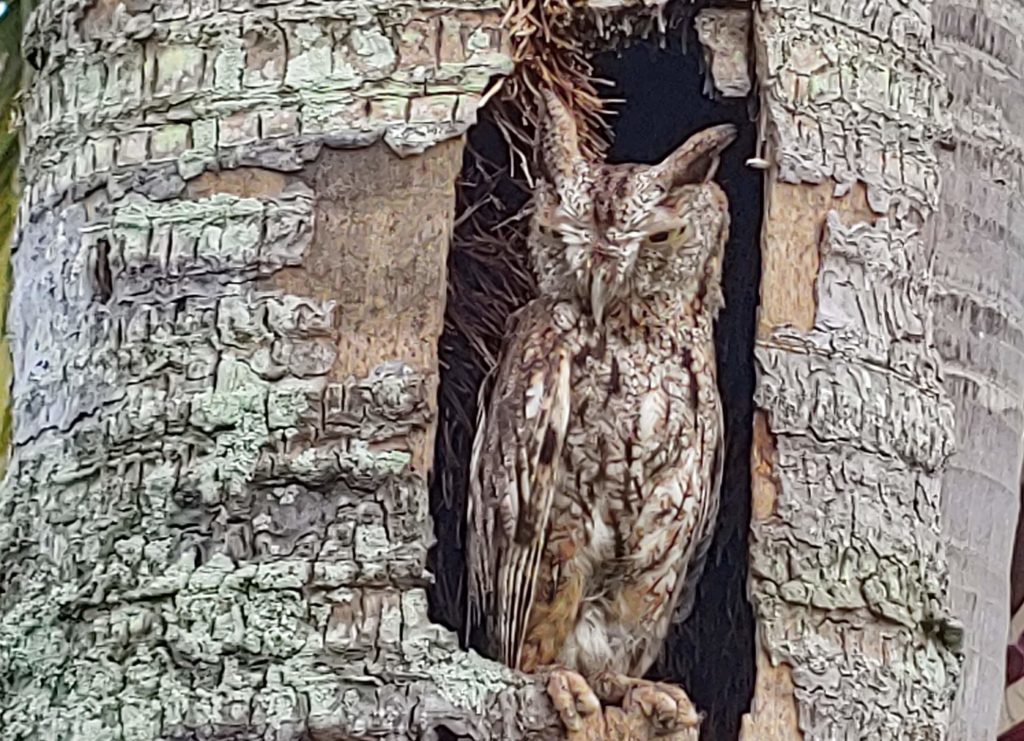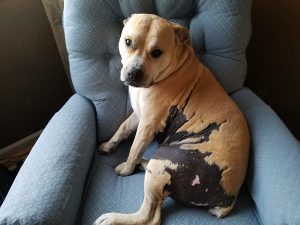Owl Time

There’s a predator lurking, just around the corner of the house. The cardinal bird says so, his excited chipping as clear a warning as a finger tapping on my shoulder.
Toward all the fussing I follow, tiptoeing barefoot through the grass. And there, just a few feet away from the sentinel cardinal, is the subject of his concerns, peering from the cavity of a dead palm—a stern visage with tufted ears and squinted eyes, and needle-tipped talons gripping the rim of its lair.
It’s a screech owl, all of seven or eight inches tall, guarding the entrance of her nest. Her gray-brown plumage is streaked and furrowed, an uncanny impersonation of bark.
Perhaps she thinks I don’t see her. Her head swivels, tracking this dimwitted creature as he creeps before her, angling for a better look while trying not to disturb the family. (There are at least two tiny, downy owlets sprawled upon the floor beneath her, confirmed with a mirror angled through the entry hole just a couple days before.) As I slink away, she’s still there, sleepy eyed and all but yawning a good riddance, as the cardinal redoubles his protests.
I savor this little moment of owl, for three immediate reasons:
• Firstly, it has come just a few hours into the morning of the longest and best day of the year, June 20, the summer solstice. This is a day perennially dedicated to all things wild. It’s a day for all things unplugged, unplasticized, unpaved: For intimate conversations with fauna and flora. For long tramps over the mountain, and bug-bitten bushwhacks through the briar patch. For contemplative spells by cliffside or seaside. From before the first pink hint of light in the eastern sky to long past the last dying embers of red in the west—filling “the unforgiving moment with sixty seconds’ worth of distance run,” as Kipling once put it. Starting the solstice with an intimate moment of owl is like starting the banquet with dessert.
• Secondly, the owl’s very presence is a victory; that her nest tree still stands, we can be proud. My little family—populated by seven domesticated carnivores and their two subservient hominids—resides in an artificial neighborhood of southwest Florida where such unkempt wildness as dead trees is decidedly frowned upon. It is a neighborhood that worships tidy square lots of manicured turf grass and a cultivated cast of decorative trees and shrubs, all of it religiously irrigated, laden with pesticides, and perpetually drunk on fertilizers.
All except ours, that is. When one of our foxtail palms died of disease not long after we moved in (probably because I declined the standard interventions of anti-fungals and phosphates prescribed by the landscaping lobby) it wasn’t long before the yard police suggested we cut it. Our response was, ‘Why thank you, but no.’
Sad as we were to lose that palm with its elegant arching leaves, we were more excited to see what might be resurrected from its deadness. A hole soon opened in its trunk, and a handsome couple of red-bellied woodpeckers moved in and raised a family. They had scarcely fledged and moved out when a pair of yellow-shafted flickers moved in and repeated the cycle. And now again, instead of a stump, we are graced by yet another new family, of little owls, sharing their lives with a level of intimacy that many people pay to see in zoos.
• Finally, our owl is a stranger bearing gifts, offering beauty, novelty, and hope in a troubled world. Her message is this: Given just half a chance, just a modicum of compassion, nature finds a way. And she returns the favor in spades, for those who think to look.
That is the essence of this and future scribblings to follow. They’re about nurturing that compassionate animal in all of us, with some wild thoughts on its care and feeding. They’re about celebrating our fellow lifeforms, embracing that noble, elusive ideal of coexistence. They’re about standing back and simply marveling. Or, when called, stepping forth and defending the downtrodden as if our lives depend on it. Because they do.
As I write this, we are now more than five months into the great coronavirus pandemic of 2020. We have just topped ten million infections worldwide, nearly half a million of us dead, and counting. We suspect the virus jumped from bat to pangolin to human in a wildlife market in Wuhan, China, where like many other markets of its ilk, creatures of all sorts are scoured from the countryside, crammed together in miserable, virus-cultivating masses, and slaughtered on sight as the customers wait.
The outbreak shouldn’t have come as a surprise. We have been duly warned for decades, by scientists, journalists and novelists, in print and screen. We’ve seen the same sorry script play out time and again, of novel viruses jumping the gap—not only from the wild animals we abuse, but from their billions of domestic brethren that we torture every day in the cruel and horrid confines of the factory farming industry. We’ve thus sickened and killed ourselves by the millions, through a burgeoning gallery of self-inflicted bugs: the Spanish flu, bird flu, swine flu, ebola, HIV, SARS, MERS. Our current calamity was never a matter of if, but when. Just as yet another, perhaps deadlier killer is brewing with our blessings, even as we struggle to see the light through the long COVID-19 tunnel.
Not that this pandemic is even the worst of the dismal fates we’re tempting. Disease is but one bad actor in league with habitat destruction, overkilling, introduced species, pollution, and our own overpopulation—the horsemen of the ecological apocalypse. The horsemen’s record of plunder we have come to see manifest in Earth’s ongoing mass extinction, with species blinking out by the hundreds every day. Our freshwater reserves are draining, our forests falling, our marine catches dropping, our soils eroding, as our own numbers climb. And global warming anyone? Epic deluge and drought, cities underwater, continents on fire—the epic has become the norm. (As I write, a weather station in the Arctic has just recorded the unfathomable mark of 100 degrees Fahrenheit.)
Honk if you’ve heard all this a hundred times already. But I am duty bound to repeat here what can’t be repeated enough: This plague is a reckoning. It has laid bare the lethal folly of our indifferences towards the very creatures that sustain us.
And here’s both the tragedy and promise of that predicament: These are indifferences we could cure in a heartbeat. What if, instead of rushing for a return to the same cruel norm that landed us in this mess, we heeded this excruciating lesson to chart a kinder path for humanity? Exploring the bright potential of that path is one of the reasons this column is being revisited after four years of cynical silence.
The other reason is that my dog has been demanding it. He is why I’ve been tottering these last few years from my regular beat in the wildlife sciences into the murky realms of anthropology, psychology, criminology, and animal welfare. He is why I’ve been seeking answers as to why somebody would burn a loving pit bull puppy and throw him out to die on a country road—and just as importantly, as to why an army of compassionate allies would step forth to help us save him.

I now live with a walking, wiggling billboard of the cruelty-and-compassion paradox that is us. Every day my joyous pup’s body mural of burn scars begs the same pivotal question as that of the covid pandemic: Who are we? Killer ape or patron saint? Planetary scourge or last-second savior?
The jury is still out on that one, but ecologists do not offer a rosy outlook for life on Earth if we don’t all start leaning heavily and hurriedly towards the kinder side of our alter egos. So that’s what this space is dedicated to. To float some questions, share some discoveries, trade some training techniques towards nurturing the compassionate animal in us.
And so it begins with an owl moment. I’ll be watching and learning as the little family grows. (Nature nerd factoid of the day: Screech owl parents sometimes deliver live blindsnakes to their nests where, by eating the fly maggots that otherwise kill baby owls, the snakes improve the little ones’ chances of survival by 25 percent.) I’m hoping to be there for the youngsters’ first peeks at the outside world, for their first terrifying leaps from the nest. I’ll be rooting for them to survive the gauntlet of fellow predators—the raccoons, crows, jays, and bigger owls—even as I wish those other predators well in their own daily trials of life. I’ll be deeply saddened if the family fails, elated if they survive, and damned if I ever let the chainsaw cult come near our decrepit little tree of life.
But for now I’m just grateful. As the longest and best day of the year winds down, I’m grateful that this little family has graced our own with a level of trust and tolerance that we would all do well to emulate.
Dianne tapped me on the shoulder and said, “read this”. Great post! Began with poetry and ended wit food for thought.
Thanks for reading. But are you sure Dianne wasn’t actually suggesting you “troll this?” She loved to give me grief.
I dare say, there is no more astute nature writer on the planet. The prose is downright gripping. Thank you for this eloquent clarion call – may it be heard far and wide.
So gratifying to read your thoughts, Caroline. And heartening just to be reminded that you’re out there, doing what you do for the animals.
I second what Caroline said and must add that My birthday is June 20, I didn’t know about the celebrating of all things wild but I do and I’m quite envious of your proximity to those owls. I’m besotted with them as anyone who sees my FB posts knows. So happy to finally see your blog.
Inspiring read. Thanks, Will!
You’re quite welcome, Jane. Thanks for visiting.